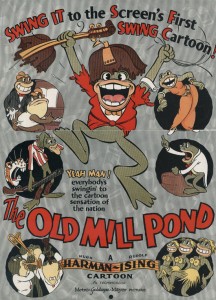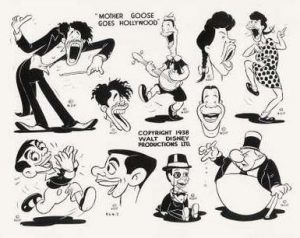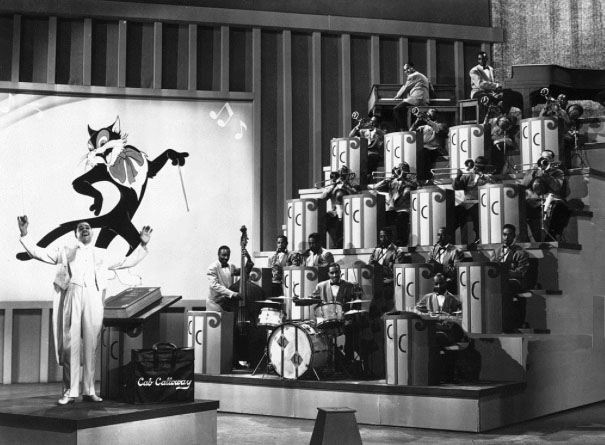The fame of Cab Calloway was not ignored at the Harman-Ising studio of the middle 1930’s.
Hugh Harman and Rudy Ising were producing cartoons for release by Metro-Goldyn-Mayer. They were far more lush than anything they had produced for Leon Schlesiger at Warner Brothers, or the two Cubby Bear shorts that they got as a contract-out job from Van Beuren.
And having what they thought were unlimited budgets from Metro meant they could try different things.
 Among the things they tried, which they had not done before, was the “all-colored” musical extravaganza.
Among the things they tried, which they had not done before, was the “all-colored” musical extravaganza.
Both The Old Mill Pond and Swing Wedding have been written up on this site by others, and need no elaborate description here.
Suffice it to say that, among the Black entertainers who are given the cartoon’s gentle razz will be found Cab Calloway–here done up as a frog, but still with immaculate white suit (with tails), nappy hair, and boundless energy. What’s more, the cartoons feature such songs as “Kicking The Gong Around” and “Minnie The Moocher’s Wedding Day”–both songs already identified with and recorded by Cab Calloway.
These frog caricatures must have proven popular with film-goers, or with exhibitors, or perhaps with both. So, Hugh and Rudy decided to fold these caricatures into another of their cartoon series.
Thus, we get a trio of cartoons that mirror the energy of the two Happy Harmonies cartoons that preceded them–while, at the same time marking an end for a well-established character that the two had brought over with them from Schlesinger’s employ.
We may never know why Harman and Ising decided to re-imagine Bosko as a humanoid “little boy”–but they did. And in his last three cartoon shorts–where he is billed as “Little ol’ Bosko” on the title cards–he finds himself iterating and reiterating what is virtually the same plot.
It’s no wonder that these cartoons are also called the “Grandma’s Cookies” cartoons. Mammy sends Bosko out into the wild to go take a bag of cookies to his Grandma. Bosko’s imagination gets the better of him, and he finds himself running athwart a group of hip frogs who want Grandma’s cookies–which Bosko is not willing to surrender.
And it doesn’t matter if Bosko thinks he is among pirates, among cannibals, or in a Baghdad that never saw the likes of Saddam Hussein, he finds peril–and plenty of rhythm.
Little Ol’ Bosko And The Pirates and Little Ol’ Bosko And The Cannibals each feature, among the frogs, a Cab Calloway clone swings out in search of Grandma’s Cookies. (For some reason, he does not appear in Little Ol’ Bosko In Bagdad–although Bosko himself gets to do a little scat singing at one point, while trying to avoid a conveyor-belt ride towards a massive dose of Castor Oil–which looks just as “ooie” and “gooie” as it does in Baby Puss some years later!
 And, even with all the rhythm that these cartoons exude–a rhythm that gets quite frenetic at time–these cartoons try to be as lush as anything that Walt Disney would put out.
And, even with all the rhythm that these cartoons exude–a rhythm that gets quite frenetic at time–these cartoons try to be as lush as anything that Walt Disney would put out.
And speaking of the Mouse House. . .
Disney is not usually associated with celebrity-caricature cartoons. But one of their Silly Symphonies–Mother Goose Goes Hollywood (1939)–shows that they could sling the caricatures just as well as any other studio.
So, when it comes time to do “Sing a Song of Sixpence”, what do we get when we get to the “four-and-twenty blackbirds baked in a pie”? Yup! More caricatures of Black entertainers–including a Cab Calloway spoof. Same white suit. . . same wild hair. . . and the same degree of energy.
Cab’s career was widing down in the 1940’s. He was still leading a big band, but he wasn’t nearly as big as he had been. Of, he wasn’t scuffling, by any stretch oft the imagination. But he wasn’t commanding as big a salary–and it may be that he was willing to take it easier.
So, it is interesting that somebody at Famous Studios–the successor to Max Fleischer’s studio, now run entirely by Paramount Pictures–remembered Cab and his hi-de-ho.
The Babysitter (1947) was one of the last of the “Little Lulu” cartoons, based on the character that Marge (Marjorie Henderson Buell) drew in panel cartoons that appeared in the “Saturday Evening Post”. And it seems to have been pointing the way towards the kind of cartoon that would feature Little Audrey the next year and onward.
Lulu is trying to baby-sit an obnoxious brat of a boy and in the process, gets knocked out. In he dream, she is chasing this boy through a stylized Manhattan, and into the Stork Club–where, it turns out, a Cab Calloway caricature is leading the orchestra.
And it turns out that, after all, Cab Calloway was not through with animation after he did the three shorts for Max Fleischer.
Sensations of 1945 (1944) was an attempt to re-do the kind of musical that Eleanor Powell had done during her tenure at Metro-Goldwyn-Mayer–light in plot, but with lots of singing and dancing to keep the customers satisfied.
Leo had let Powell go, after she had done what almost amounted to a cameo in Thousands Cheer (1943). But somebody thought she still had “it”, and produced a film around her and a bevy of other entertainers–including Cab Calloway. Cab had a couple of feature numbers in the picture, and one of them also featured some animation by an un-credited studio (though I think we can make an educated guess as to the identity of the animator).

The number was one that Cab had in his book for several years–“Mr. Hepcat’s Dictionary”, which was inspired by (or which may have inspired) a pamphlet attributed to Cab which defined “hipster” lingo.
Cab is sanding on a small stage, while his orchestra sits on a slightly larger one. There’s also a child actor, dressed up in a miniature version of what Cab is wearing.
And there is a big screen center-stage, on which is projected the image of a “hepcat”–a feline character, not a zoot-suiter.
Between verses of the song, Cab is making his signature moves–and the “hepcat” on screen is trying moves of his own.
Had this film been blessed with a higher budget, the scene might have been a glorious opportunity for more rotoscoping. I suspect that process was not used here — and if that isn’t McKimson animation… I don’t know what is (The film’s producer/director Andrew L. Stone hired Leon Schlesinger’s studio to produce a bit of animation in his previous film, Hi Diddle Diddle, also for UA. I think its safe to assume Leon was contracted to provide this as well).
It’s a short number, and one can easily see where it might be sniped out from the print for those venues where local censors did not want scenes featuring African-American players to grace the black-and-white screens of their lily-white theaters.
The pic was released through United Artists, but it is usually seen today in a reissue print handled by that most extreme of bottom-feeders: Astor Pictures.
Cab Calloway never really retired. He always seemed to be popping up–here in a production of “Porgy and Bess”, where he played a character that was inspired by him in the first place; there cutting a soppy duet with his daughter Lael (“Little Child”),’ then again covering a monologue by journeyman country singer Buddy Starcher, detailing the parallels between Abraham Lincoln and John F Kennedy.
Even in the age of “disco”, Cab would be rediscovered yet again, showing that his hi-de-ho was, in fact, quite timeless.
And, in the early 1980’s, when the old “Betty Boop” cartoons that had featured him showed up on VHS, another new generation marveled at his moves, and wondered if Michael Jackson had stolen them.
Next Week: Felix Keeps On Walking


 James Parten has overcome a congenital visual disability to be acknowledged as an expert on the early history of recorded sound. He has a Broadcasting Certificate (Radio Option) from Los Angeles Valley College, class of 1999. He has also been a fan of animated cartoons since childhood.
James Parten has overcome a congenital visual disability to be acknowledged as an expert on the early history of recorded sound. He has a Broadcasting Certificate (Radio Option) from Los Angeles Valley College, class of 1999. He has also been a fan of animated cartoons since childhood.












































I love the look of he Bosko/Frogs cartoons, otherwise known as the “Gramma’s Cookies cartoons”. I don’t have any idea why songs exclusive to each cartoon couldn’t have been composed, but the song was identical, almost to the point that, when I saw two of the three cartoons, I thought that this particular Bosko “story book” episode was one long feature, similar to Max Fleischer’s “POPEYE MEETS SINBAD”, with the saga beginning with Bosko barely escaping the pirates to Bosko’s jazzy journey to Baghdad.
This confusion was compounded because, almost every time I encountered these cartoons on a local TV station, our ABC affiliate, I’d tuned in halfway through the cartoon. I never did see these cartoons multiple times enough to recognize each as separate entities, except for “LI’L OL’ BOSKO AND THE PIRATES” which aired one Saturday morning just before that afternoon’s airing of “AMERICAN BANDSTAND”. Yes, this was way before Saturday morning TV had its own budgeted cartoons made for the new medium, although classic MGM cartoons were sandwiched in between episodes of “COURAGEOUS CAT” or “Q. T. HUSH”.
“BOSKO AND THE PIRATES” was, I have to admit, a visual treat, not only because the cartoon opens like a storybook. When I was a kid, I used to think that, somewhere, at some bookstore in my dreams, there was a lavish, hard cover book of this story, with illustrations that looked like the stills or cells from this cartoon, and in some scenes, you could see the background bobbing gently up and down as the pirates chase Bosko, in time to the ebb and flow of the jazz music.
There was one signifigant thing about all Bosko cartoons from MGM that I managed to physically see before losing my sight, and that is that they’d start out slow and then build to this chaotic climax, and “PIRATES” is literally explosive! The ship blows up as Bosko’s frenetic tap dancing is so “hot” that it sends an ember down to the ship’s cargo which is boxes and boxes of dynamite sticks. As the ship goes down, the captain, bravely going down with his ship, grumbles “Those cookies, those cookies, I love them, I love them!”
The Cab Calloway caricature mentioned in this article is so wild that he stumbles and crashes down through the deck of the ship, and Bosko looks down through the hole in horror; can’t imagine what he sees, but the pirates are certainly scary in their obsession of “those cookies”. The pirate king, at one point, screams out “those cookies!”, grabs two of his shipmates by the heads and slams the heads together in a frenzy!
A fine article, please keep ’em coming!
You left out one Cab Calloway inspired cartoon. When Aladdin was first being written, the Genie was conceived as a Calloway-type character. “Friend Like Me” sounds just like something Calloway would perform, and at one point Genie dances in white coattails and does some scatting.
It should also be noted that SENSATIONS OF 1945 contains a short scene with W.C. Fields in what was his last film appearance.
Calloway also found himself used in several TV commercials for a UK brand of snack called “Hula Hoops” aired during the late 80’s, also cleverly animated!
https://www.youtube.com/watch?v=KsR3Bi272ig
https://www.youtube.com/watch?v=SY7X-8Kfvcc
https://www.youtube.com/watch?v=DULjPIlvlp4
I’m surprised you mentioned the early 80’s era of Cab Calloway’s career but not his role in the Blues Brothers! To my age group that was pretty much our introduction to him and Minnie the Moocher! I saw him in that even before I saw him as a ghost Walrus dancing with Betty Boop! Great article though!
Here in Los Angeles, Bill Handel, who has a general talk show daily and a “Handel on the Law” on Saturday, uses Cab Calloway’s “Minnie the Moocher” for his theme song. He’s on KFI AM 640.